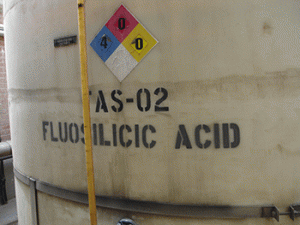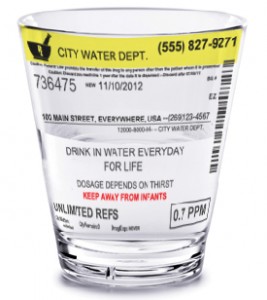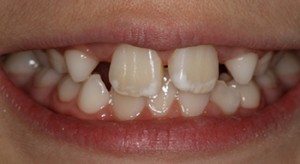10 Facts About Fluoride
Fact #1: Most Developed Countries Do Not Fluoridate Their Water
In the United States, health authorities call fluoridation “one of
the top 10 public health achievements of the 20th century.” Few other
countries share this view. In fact, more people drink artificially
fluoridated water in the U.S. alone than in the rest of the world combined.[1] Most advanced nations do not fluoridate their water. In western Europe,
97% of the population has water without a single drop of fluoride added
to it.[2] Fluoridation proponents will sometimes say this is because
Europe adds fluoride to its salt. Only five nations in western Europe,
however, have any fluoridated salt.[3] The vast majority do not.
Fact #2: Fluoridated Countries Do Not Have Less Tooth Decay Than Non-Fluoridated Countries
It is often claimed that fluoridated water is the main reason the
United States has had a large decline in tooth decay over the past 60
years. This same decline in tooth decay, however, has occurred in all developed countries,
most of which have never added any fluoride to their water.[4] Today,
according to data from the World Health Organization, there is no
discernible difference in tooth decay between the minority of developed
countries that fluoridate water, and the majority that do not.[5]
Fact #3: Fluoride Affects Many Tissues in the Body Besides the Teeth
Fact #10: Disadvantaged Communities Are the Most Disadvantaged by Fluoride
Fluoridation advocates have long claimed that the safety of
fluoridation is beyond scientific debate.[6] However, according to the
well-known toxicologist, Dr. John Doull, who chaired the National
Academy of Science’s review on fluoride, the safety of fluoridation
remains “unsettled” and “we have much less information than we should,
considering how long it has been going on.”[7] In 2006, Doull’s
committee at the NAS published an exhaustive 500-paFluoridation advocates have long claimed that the safety of fluoridation is beyond scientific debate.[6] However, according to the well-known toxicologist, Dr. Johge review of fluoride’s toxicity.[8] The report concludes that fluoride is an “endocrine disruptor” and can affect many things in the body, including the bones, the brain, the thyroid gland, the pineal gland, and even blood sugar levels.[9]
NRC (2006)
Far from giving fluoride a clean bill of health, the NAS called upon scientists to investigate if current fluoride exposures in the United States are contributing to chronic health problems, like bone disorders, thyroid disease, low intelligence, dementia, and diabetes, particularly in people who are most vulnerable to fluoride’s effects.[10] These recommendations highlight that—despite 60 years of fluoridation—many of the basic studies necessary for determining the program’s safety have yet to be conducted.
Fact #4: Fluoridation Is Not a “Natural” Process
 Fluoridation
advocates often say that “nature thought of fluoridation first.” By
this, they mean that fluoride occurs at naturally high levels in some
water supplies.[11] Lots of toxic substances, however, like arsenic,
and even some medicines, like lithium, occur at naturally high levels.
This doesn’t mean they’re safe.[12] Further, the level of fluoride added
in artificial fluoridation programs is far higher than the level of
fluoride that occurs in the vast majority of (unpolluted) fresh surface waters.[13]
Fluoridation
advocates often say that “nature thought of fluoridation first.” By
this, they mean that fluoride occurs at naturally high levels in some
water supplies.[11] Lots of toxic substances, however, like arsenic,
and even some medicines, like lithium, occur at naturally high levels.
This doesn’t mean they’re safe.[12] Further, the level of fluoride added
in artificial fluoridation programs is far higher than the level of
fluoride that occurs in the vast majority of (unpolluted) fresh surface waters.[13]Also, the main fluoride chemical (fluorosilicic acid) that is added to water is not what most people would call a naturally occurring compound. It is a corrosive acid captured in the air poFact #10: Disadvantaged Communities Are the Most Disadvantaged by Fluoridellution control devices of the phosphate fertilizer industry.[14] Fluoride is captured in air pollution control devices because fluoride gases are hazardous air pollutants that cause significant environmental harm.[15] This captured fluoride acid is the most contaminated chemical added to public water supplies,[16] and may trigger additional risks from those presented by natural fluorides. These risks include a possible cancer hazard from the acid’s elevated arsenic content, and a possible neurotoxic hazard from the acid’s ability–under some conditions–to increase the erosion of lead from old pipes.[17]
Fact #5: 40% of American teenagers show visible signs of fluoride over-exposure.
Dental Fluorosis (Photo by Dr. Jay Levy)
The high rate of fluorosis in the U.S. reflects the fact that children now receive fluoride from many sources besides tap water. When fluoridation first began, there was not a single tube of toothpaste that contained fluoride. Today, over 95% of toothpastes are fluoridated. Although fluoride toothpastes carry poison warnings on them, studies show that children can swallow large amounts of fluoride when they brush, particularly when using toothpaste with bubble gum and candy flavors.[22]
And there are other sources of fluoride as well, including processed beverages/foods,[23] fluoride pesticides,[24] tea,[25] Teflon pans,[26] and some fluorinated pharmaceuticals. [27] The concern today, therefore, is not just the safety of fluoridated water by itself, but the safety of fluoridated water in combination with all the other sources to which we’re now exposed.
Fact #6: For Infants, Fluoridated Water Provides No Benefits, Only Risks
 Up until the 1990s, health authorities advised parents to give fluoride to newborn babies. This is no longer the case.
Today, the Institute of Medicine recommends that babies consume a
minuscule 10 micrograms of fluoride per day.[28] This is roughly the
equivalent of what babies ingest from breast milk, which contains
virtually no fluoride.[29]
Up until the 1990s, health authorities advised parents to give fluoride to newborn babies. This is no longer the case.
Today, the Institute of Medicine recommends that babies consume a
minuscule 10 micrograms of fluoride per day.[28] This is roughly the
equivalent of what babies ingest from breast milk, which contains
virtually no fluoride.[29]Infants who consume formula made with fluoridated tap water consume up to 700 to 1,200 micrograms of fluoride, or about 100 times more than the recommended amount. According to the CDC, these early spikes of fluoride exposure during infancy provide no known advantage to teeth.[30] These spikes can, however, produce harm.
Recent studies show that babies who are given fluoridated water in their formula develop significantly higher rates of dental fluorosis.[31] Because of this, a number of prominent dental researchers now advise that parents should not add fluoridated water to baby formula.[32]
And teeth are not the only concern. In July of 2012, scientists from Harvard University warned that the developing brain may be another target for fluoride toxicity.[33] The Harvard team based their warning on a large number of studies from China that have found reduced IQ scores among children exposed to elevated fluoride during their early years of life. Twelve of the studies the Harvard team reviewed found IQ loss at fluoride levels deemed safe in the U.S. and a study sponsored by UNICEF found IQ loss in iodine-deficient children at the so- called “optimal” fluoridation level.[34] According to the senior Harvard scientist who conducted the review, the possibility that fluoridated water can reduce IQ is a matter that “definitely deserves concern.”[35]
Fact #7: Fluoride Supplements Have Never Been Approved by the FDA
 Fluoride “supplements”
are designed to provide children the same dose of fluoride they would
receive by drinking fluoridated water.[36] Unlike other dietary
supplements, however, you can’t just walk into a grocery store and buy a
fluoride supplement. Because of fluoride’s toxicity, you can only buy a
fluoride “supplement” if you have a doctor’s prescription. Yet,
although federal law requires that prescription drugs be approved as
safe and effective by the FDA,[37] the FDA has never approved fluoride supplements for the prevention of tooth decay.[38] In fact, the only fluoride supplements the FDA has reviewed, have been rejected.[39]
So, with fluoridation, we are adding to the water a
prescription-strength dose of a drug that has never been approved by the
FDA.
Fluoride “supplements”
are designed to provide children the same dose of fluoride they would
receive by drinking fluoridated water.[36] Unlike other dietary
supplements, however, you can’t just walk into a grocery store and buy a
fluoride supplement. Because of fluoride’s toxicity, you can only buy a
fluoride “supplement” if you have a doctor’s prescription. Yet,
although federal law requires that prescription drugs be approved as
safe and effective by the FDA,[37] the FDA has never approved fluoride supplements for the prevention of tooth decay.[38] In fact, the only fluoride supplements the FDA has reviewed, have been rejected.[39]
So, with fluoridation, we are adding to the water a
prescription-strength dose of a drug that has never been approved by the
FDA.
Fact #8: Fluoride Is the Only Medicine Added to Public Water
 Fluoride
is the only chemical added to water that doesn’t actually treat the
water. Chlorine, for example, is added to kill bacteria so that we can
drink the water without getting sick. Fluoride, by contrast, is added to
prevent a disease (tooth decay) that is not caused by drinking water.
Fluoride
is the only chemical added to water that doesn’t actually treat the
water. Chlorine, for example, is added to kill bacteria so that we can
drink the water without getting sick. Fluoride, by contrast, is added to
prevent a disease (tooth decay) that is not caused by drinking water.Fluoridation proponents claim that fluoridated water is not a medication because, in their view, it’s no different than adding iodine to salt or vitamin D to milk. What proponents fail to acknowledge, however, is that iodine and vitamin D are both essential nutrients; but fluoride is not.
An essential nutrient is something the body has a physiological demand for. If we don’t have enough iodine, for example, our thyroid gland won’t function properly. Although fluoride advocates sometimes claim that fluoride is a “nutrient,” the National Academy of Sciences has repeatedly confirmed that this is not the case.[40]
Because fluoride is not a nutrient, the FDA has defined fluoride as a medicine when used to prevent disease.[41] Since tooth decay is a disease, adding fluoride to water to prevent tooth decay is — as a matter of logic — a form of medication. This is one of the reasons why most European nations have rejected fluoridation: because, in their view, the water supply is an inappropriate way to deliver medicine.[42] With other medicines, it is the patient, not the doctor, who has the right to decide which drug to take.[43] Fluoridation denies people this right.
Fact #9: Swallowing Fluoride Provides Little Benefit to Teeth
When water fluoridation first began back in the 1940s, the medical profession believed fluoride needed to be ingested
to be most effective in preventing cavities.[44] This was why fluoride
was added to water and pills—because these are things that people
swallow.Today, however, it is now widely recognized that fluoride’s main benefit does not actually come from ingestion, it comes from fluoride’s topical contact with teeth[45]—a fact that even the CDC has now acknowledged.[46] So, not only does fluoridation add a medicine to water, it adds a medicine that does not actually need to be swallowed.
Fact #10: Disadvantaged Communities Are the Most Disadvantaged by Fluoride
 In the United States, there is a serious shortage of dentists
who will treat low-income patients.[47] The claim, however, that we can
compensate for this lack of care by forcing poor populations to consume
fluoridation chemicals in their water is a dangerous one.
In the United States, there is a serious shortage of dentists
who will treat low-income patients.[47] The claim, however, that we can
compensate for this lack of care by forcing poor populations to consume
fluoridation chemicals in their water is a dangerous one.The conditions that make people more vulnerable to fluoride toxicity are far more prevalent in poor communities than affluent ones (e.g., nutrient deficiencies, infant formula consumption, kidney disease, and diabetes).[48] This likely explains why African American and Mexican American children suffer significantly higher rates of dental fluorosis.[49] These disparities in fluoride risk have led several prominent civil rights leaders—including Andrew Young and the nation’s largest Hispanic civil rights organization—to call for an end to fluoridation.[50]
Despite claims that fluoridation can prevent the high rates of tooth decay seen in poor areas, the vast majority of poor urban communities have been fluoridated for over 30 years, and yet are still suffering from a severe oral health crisis.[51] In fluoridated Cincinnati, the dental director described the state of oral health among poor children as “absolutely heartbreaking and a travesty,” adding that “people would be shocked to learn how bad the problem has become.’”[52] Many other cities have experienced the same fate. For example:
- In (fluoridated) Detroit, 91% of 5-year-old black children have tooth decay, with 42% suffering from “severe” decay.[53]
- In (fluoridated) New York City, 34% of pre-school black children from low-income families have rampant tooth decay, with a staggering 6.4 cavities per affected child.[54]
- In (fluoridated) Chicago, 64% of third graders have tooth decay.[55]
- In San Antonio, annual head start surveys show that fluoridation failed to reduce the high rate of tooth decay among the city’s head start children. After eight years of fluoridation, the tooth decay rate did not decrease–it increased.[56]
- Untreated tooth decay in fluoridated urban areas has led to several deaths, including a 12-year-old child in Prince Georges Maryland, and a 24-year-old father in Cincinnati.[57]
 The simple fact is that poor populations need dental care, not fluoridation chemicals in their water.
The millions of dollars spent each year promoting fluoridation would be
better spent advocating for policies that provide real dental care:
like allowing dental therapists to provide affordable care to
populations with little access to dentists.[58] In short, fluoridation
provides good PR for dental trade associations, but bad medicine for
those it’s supposedly meant to serve.
The simple fact is that poor populations need dental care, not fluoridation chemicals in their water.
The millions of dollars spent each year promoting fluoridation would be
better spent advocating for policies that provide real dental care:
like allowing dental therapists to provide affordable care to
populations with little access to dentists.[58] In short, fluoridation
provides good PR for dental trade associations, but bad medicine for
those it’s supposedly meant to serve.




No comments:
Post a Comment
Let us know what you think!